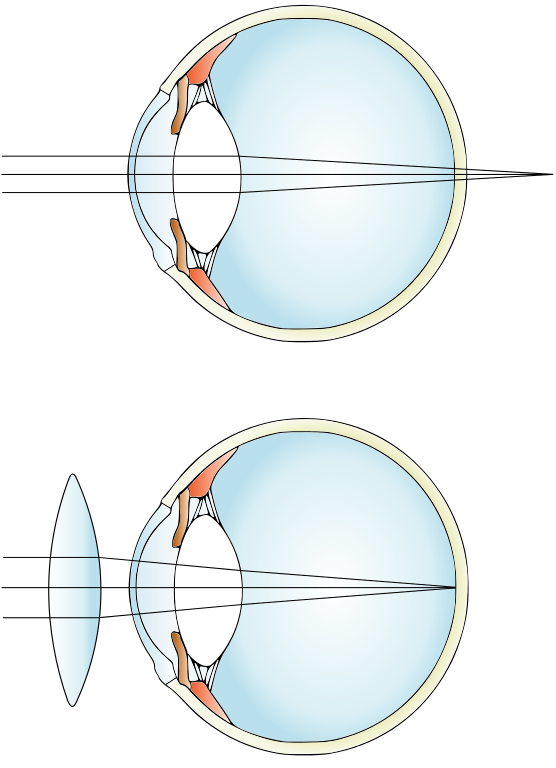Difference Between Myopia and Hypermetropia
Myopia and Hypermetropia are both common eye conditions. Myopia is also known as short sightedness in which a person can see clearly the near objects, whereas the faraway objects appear blurred. On the other hand, Hypermetropia, also known as long sightedness is a condition in which a person can see clearly far away objects but the near ones appear blurry and not normal. These conditions do not happen because of watching too much TV or due to working on computer or reading books. These are actually birth defects and happen when the shape of the eye balls and the eye balls are incorrect.
What is Myopia?
Myopia is a hereditary disease, which means that probability for somebody to develop short sightedness (Myopia) proliferates if their parents also have the same disorder. In addition, the threat of developing short sightedness may increase because of several environment related cues, for e.g. a kid not getting enough exposure to sunlight, or kid not going out and spending too much of time inside or investing too much time on doing some close to eye work and straining eyes. Also, sex, age factor, ethnic traits and body’s biological clock i.e. body rhythms can also influence the development of Myopia. However, other than heredity, everything else is hypothetical, as there is not enough information available to establish a correlation.
What is Hypermetropia?
Hyperopia or Hypermetropia on the other hand, is an eye disorder which is commonly known as long sightedness, which means that this eye condition is the opposite of myopia. In hyperopia, items that are nearby appear to be blurry, while as far away things look normal. This is due to the reason that the eyeball is very short in this condition, that leads to the incoming light to fall behind the retina, because of which things appear blurry.
Hypermetropia can develop due to a number of reasons. One of the reasons is that an individual is born with too short eye ball, means it is a birth defect. However, in some cases as the child grows into an adult, the eye gets elongated and thus the defect gets corrected by itself. In cases where this does not happen, the individual does not have a choice than to live with hypermetropia for the rest of his life. Another reason for developing long-sightedness could be the low converging power of the eye lens due to incapacitated function of ciliary muscles. Such a development could also happen because of age factor, as the ciliary muscles get more and more weak with growing age. In rare instances, hypermetropia may also be caused by high blood sugar (diabetes), as well as because of disorders with the blood vessels in the eye retina.
Figure 1. Myopia and Hyperopia
Difference between Myopia and Hypermetropia
Description
Myopia
Myopia is also termed as near-sightedness. It is a common type of refractive error in which nearby items appear normal and clear, but distant objects look blurry.
Hypermetropia
Hyperopia or Hypermetropia is also termed as far-sightedness. It is also a refractive error in which faraway items appear clear and normal than the close objects.
Shape
Myopia
Myopia happens when the eyeball is very long, which averts incoming light from focusing straight on the retina.
Hypermetropia
Hypermetropia happens when the eyeball is very short, which averts incoming light from focusing straight on the retina.
Effect
Myopia
High Myopia increases the risk of Retinal detachment. High myopia also increases the danger of cataract and glaucoma. Cataract is the clouding of lens of an eye. Glaucoma is a kind of disease that causes increased pressure within the eyeball, damaging the optic nerve (Optical nerve carries signals from the retina to the brain) and can cause gradual loss of sight.
Hypermetropia
High Hypermetropia causes lazy eye (amblyopia). It also causes Squint (Strabismus) in Children.
Diagnosis
Myopia
It can be diagnosed by eye exam by a trained eye care practitioner. The exam includes visual acuity test, i.e. reading things on a table. This is often followed by using a retinoscope to see the reflection off the retina by shining light to assess the volume of refractive error present.
Hypermetropia
Diagnosis of hypermetropia is based on the symptoms and clinical signs observed. The clinical signs include visual acuity, cover test, examination of eyeballs, eye lids and cornea, lens examination which may be dislocated backwards. Apart from these tests- scan ultrasonography or biometry that shows reduced antero- posterior length of the eyeball.
Treatments
Myopia
Can be treated by use of concave lens eye glasses, or corrective eye surgery.
Hypermetropia
Can be treated by use of convex lens eye glasses, or corrective eye surgery.
Symptoms
Myopia
Tired and strained eyes, headache, frowning, squinting, blurred vision.
Hypermetropia
Squinting to see better, blurred vision, headaches, fatigued and strained eyes. In kids, strabismus (crossed eyes) can happen when significant long-sightedness has not been diagnosed.
Causes
Myopia
Genetics. Sex, age, ethnic attributes, body’s circadian rhythms and environmental exposures – like sunlight
Hypermetropia
Birth disorder, short eyeball, high blood sugar, weak functioning of ciliary muscles and problems with the blood vessels in the eye retina.
Summary of Myopia and Hypermetropia
The points of difference between Myopia and Hypermetropia have been summarized below:
Comparison Chart : Myopia Vs. Hypermetropia
- Difference Between Global Warming and Greenhouse Effect - May 18, 2024
- Difference Between Vaccination and Immunization - March 3, 2024
- Difference Between Selective Mutism and Autism - February 25, 2024
Search DifferenceBetween.net :
Leave a Response
References :
[0]Image credit: https://upload.wikimedia.org/wikipedia/commons/thumb/a/a7/Hypermetropia_color.svg/556px-Hypermetropia_color.svg.png
[1]Image credit: https://commons.wikimedia.org/wiki/File:Myopia.gif#/media/File:Myopia.gif
[2]Llorente, L., Barbero, S., Cano, D., Dorronsoro, C., & Marcos, S. (2004). Myopic versus hyperopic eyes: axial length, corneal shape and optical aberrations. Journal of Vision, 4(4), 5-5.
[3]Wen, G., Tarczy-Hornoch, K., McKean-Cowdin, R., Cotter, S. A., Borchert, M., Lin, J., ... & Varma, R. (2013). Prevalence of myopia, hyperopia, and astigmatism in non-Hispanic white and Asian children: multi-ethnic pediatric eye disease study. Ophthalmology, 120(10), 2109-2116.




